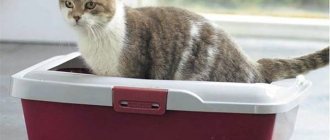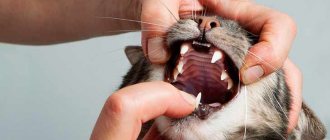If a cat poops with blood, in most cases this is really a reason to urgently contact a veterinarian. This phenomenon usually indicates serious problems in the pet’s health.
Extravasates (blood clots) in a cat’s feces should be absent during normal functioning of the digestive tract, so the owners should not ignore their appearance. However, it happens that if a cat poops with blood, then this is not at all a symptom of a serious illness, but only when such a case is one-time, and not repeated from time to time.
© shutterstock
Causes of blood in stool
Normal cat stool should not contain foreign matter. But if a vigilant owner notices that there is mucus or bloody spots in the stool, monitoring the further behavior and condition of the pet becomes a first necessity.
There are different reasons why blood appears in a cat's stool.:
- bacteria or viral infection;
- protozoa;
- worms;
- poisoning by stale food or poisons (for example, from rodents);
- ingestion of inedible objects, tubular bones, causing injuries to the intestines and stomach;
- poor blood clotting;
- constipation, intestinal obstruction due to a sudden change in the usual diet or food from the host’s table;
- exclusively dry food with a lack of drinking;
- dense balls of hair in the stomach (especially typical for long-haired breeds);
- stomach ulcers, problems with the pancreas;
- colitis in chronic form with intestinal ulcerations;
- hepatic dystrophy;
- overgrown benign polyps;
- intolerance to certain foods or feeds, allergies;
- cancerous tumors of the lower intestine;
- injuries or other damage to the anus, lower intestines.
© shutterstock
It is clear that not every owner will be able to immediately correctly understand the causes of blood in a cat’s feces, so to be on the safe side, many turn to a specialist without waiting for events to develop. And they are doing the right thing, because delaying time can turn into a big problem for the cat’s health.
It happens that after an appointment, the veterinarian determines a reason that is comforting for the owners: residual effects of anthelmintics or simply the need to reconsider the cat’s diet. This means that the pet has no diseases as such, and you can soon expect the worrying symptoms to disappear. But, unfortunately, most often blood in the stool is a sign of ill health.
If the cat pooped and blood was noticed in the stool, it is better not to use litter temporarily, as it is more difficult to see foreign impurities in it.
The cat is bleeding - causes and first aid
The appearance of blood in a cat always frightens owners, especially for pets living in an apartment, when, in general, there are no external reasons for bleeding. It must be remembered that blood in a cat occurs with minor damage to the skin and mucous membranes, for example, with abrasions, but it can be a sign of a general illness or deep lesions of the skin. This article will help you understand at home how dangerous bleeding is in your pet.
The circulatory system in cats, like in other mammals, is of a closed type. In simple terms, blood flows in a circle, more precisely through vessels (hollow tubes) that form two circles of blood circulation. The movement of blood is ensured by the heart (muscle pump, contraction of the walls of blood vessels, valves of the veins), while the blood always moves in one direction, arterial blood (rich in oxygen and nutrients) - from the heart to the organs and tissues; venous (with carbon dioxide and metabolic products) - from organs and tissues to the heart. The question arises: how then does the body nourish itself if the circulatory system is closed?
In tissues and organs, vessels branch into tiny capillaries with the thinnest walls; the walls of all vessels have pores; as a result of this structure of the vascular system, gas exchange and transport of substances occur. The blood itself is a liquid medium, consisting of blood cells and plasma, and due to a number of mechanisms in healthy animals, the blood in the vessels does not clot.
Any damage to the walls of blood vessels of a traumatic or inflammatory nature, as well as blood diseases, lead to bleeding in the animal. Depending on the type of damaged vessel, arterial (from arteries) and venous (from venous vessels) bleeding are distinguished.
Arterial bleeding is the most dangerous, since it is almost impossible to stop the bleeding on your own; surgical intervention is often required. Scarlet blood appears from the arterial vessels, which pulsates, especially strongly from large arteries; arterial bleeding can continue for a long time.
With venous bleeding, dark, cherry-colored blood appears, there is no pulsation, and if small vessels are damaged, it can stop on its own. If there is severe venous bleeding from large vessels, the cat should be shown to a doctor.
Bleeding from the capillaries is usually minor, not life-threatening for the cat, and stops quickly.
When to take your pet to the doctor
You should contact your veterinarian in the following cases::
These manifestations are often accompanied by additional symptoms:
- decreased appetite;
- diarrhea with vomiting;
- increased frequency of urination;
- lethargy, apathetic mood of the pet;
- pronounced thirst;
- sudden weight loss;
- the cat runs its butt on the carpets (a sign of problems with the anal sinuses).
With these signs, you also need to observe how many times a day the cat walks around, how often there is blood and how much of it, whether there are other foreign impurities (mucus, remains of fur or undigested food, etc.). You also need to pay attention to the cat’s behavior and mood, how he eats, how much he drinks, whether there is vomiting and fever. You will need to tell the veterinarian about all this when your pet comes in for an appointment. This will help speed up diagnosis and initiation of treatment.
© shutterstock
Causes of pathology
When cleaning up the pet's potty, the owner may discover that there are several drops of blood on the feces, or that the entire mass of feces is colored reddish. Let us note right away that this is not normal, and such a signal indicates that the animal needs increased observation and attention from humans.
If blood was detected in the stool of a furry pet once, the symptom did not recur again, and the general condition of the animal is assessed as good (that is, the pet is cheerful, cheerful, eats, actively responds to affection), there is no need to worry. Most likely, there was a one-time injury to the animal’s rectum (for example, the mucous membrane could have been scratched by a sharp piece of undigested food or a small foreign object that came out naturally).
If blood appears in the stool again and again, you need to find out the reason for its appearance immediately. In a situation where bloody spots in the animal’s feces are accompanied by such manifestations as lethargy or lethargy of the pet, diarrhea or constipation, refusal to eat, increased or decreased body temperature (the norm for an adult cat is within 38-39 degrees), you need to take the pet to the clinic immediately.
The determining factors due to which a cat goes “out of need” with blood for some time are mainly the following:
- intussusception;
- gastroenteritis;
- stomach ulcer;
- helminthic infestation;
- dysbiosis accompanied by constipation;
- vascular diseases;
- bacterial infection;
- injury to the anus or intestines;
- allergic reactions;
- blood clotting failure;
- foreign objects;
- severe intoxication (when chemicals enter the body);
- benign and malignant tumors.
Blood in your cat's stool is most often caused by irritation in the lower intestine. In addition to the symptoms of hematochezia, allergies and food intolerance can be caused in pets by ordinary food, most often dry food from a dubious manufacturer.
If your cat spends most of its life in the yard or on the street, then it may have been poisoned by rat poison, then bloody stools are a common occurrence. Also, if you notice very hard and extremely dry stools in your cat, then these are clear signs that the animal has nutritional problems.
Among other things, parasites, E. coli, bacteria, worms and other agents carrying viruses of various etiologies can also cause diseases accompanied by bloody feces. Therefore, always, as a caring owner, make sure that your beloved cat does not eat just anything, anywhere, but eats normally and drinks plenty of fluids.
Diagnostics
Based on the owner’s story, the pet will first need to undergo a study to clarify the alleged diagnosis:
- test feces for protozoa, helminths and coprogram (just in case, it is better to collect a test ready before visiting the doctor);
- donate blood (detailed form of analysis);
- collect a urine test (if required);
- take an x-ray or ultrasound of internal organs;
- do a colonoscopy (examination of the large intestine with an endoscope).
Such an examination will allow the doctor to determine exactly why the cat appeared in feces with blood, after which the animal will be prescribed targeted treatment.
Treatment Options
Therapy depends on the diagnosis. For almost every reason, antispasmodics, anti-inflammatory, and painkillers are first given. Antibiotics are prescribed only when the underlying disease is advanced. If necessary, use vitamins and medications that increase immunity and stop bleeding. A catheter is placed if there is difficulty urinating. The tumors are removed, and a special diet is prescribed for stones.
Even before going to the clinic, it is recommended to improve your pet’s well-being. You cannot help thoughtlessly; it is better to contact a veterinarian. Typically, home care involves moving the cat to a dry area, providing rest and access to water. Additionally, it is necessary to replace the food with liquid food, give decoctions of juniper and horsetail, bearberry or parsley.
How to treat
The treatment prescribed by the doctor will depend on the problem identified during diagnosis.:
- for a viral disease - antiviral drugs;
- for bacterial infections – antibiotic therapy;
- if the cause is hairballs, special foods or pastes will remove them from the digestive organs;
- wall ruptures (perforation), poisoning with bleeding or poor clotting are treated with vitamin K and hemostatic drugs;
- against protozoa and parasites - special remedies for them;
- if there are problems with the liver or pancreas - enzymes to restore digestion, hepatoprotectors to protect the liver;
- for dysbacteriosis, enterocolitis, colitis, allergies and constipation - probiotic preparations and a special light diet;
- if a foreign body has entered the intestines, polyps have grown, or a malignant tumor has formed, recovery can only be achieved through surgery.
In other words, each individual case receives individual treatment.
© shutterstock
Treatment of a cat if blood is detected in the stool
The therapeutic plan is drawn up taking into account the cause of the disease. Treatment in a veterinary clinic is required only for animals in serious condition. In most cases, a cat needs to be treated with medications, and the owner needs to ensure that the pet not only takes medications in a timely manner, but also has high-quality nutrition during this period.
Important! If malfunctions of the pancreas or liver are detected, the cat is recommended to follow a diet and take medications with enzymes, for example, Pancreatin.
Blood in a cat's urine - natural causes
A change in the color of urine or its composition is not always a sign of pathology. Sometimes it can be caused by the physiological characteristics of the pet’s body (relevant for females). The following can lead to the appearance of blood clots in urine:
- estrus – when urine mixes with genital secretions;
- bearing offspring - when the body is reconstructed and prepared for the appearance of offspring;
- the period after childbirth - when vaginal discharge continues after lambing.
All of the above factors are not a cause for concern. The exception is prolonged bleeding, which requires diagnosis and consultation with a specialist.
Diagnosis of the patient's condition
It is not always possible to identify hematuria in a pet on your own. Sometimes the owner of the pet learns that there is blood in a cat’s urine only after microscopy of its biological material.
Important: the analysis allows us to establish not only the fact of the presence of hematuria, but also the source of the bleeding. In accordance with it, it can be extrateral, renal and postrenal.
Extrateral - the urinary system is involved secondarily (a consequence of systemic diseases accompanied by hemorrhagic syndrome).
Renal - occurs when the source of bleeding is located in the kidneys.
Postrenal – the result of injury to the urinary tract and bladder.
To find the root cause of hematuria, veterinarians conduct a comprehensive examination of animals, which includes:
- collection of anamnestic data;
- initial examination;
- performing laboratory tests (general urine analysis, biochemical blood test, etc., etc.).
In some cases, the cat is sent for further examination. In particular, she may undergo cystoscopy, radiography or ultrasound of the abdominal organs, and other studies aimed at differential diagnosis and making an accurate diagnosis.
Treatment and prevention
Depending on the causes of symptoms, the following means and methods are used in treatment:
- Medications. In case of severe losses, hemostatic agents are prescribed. They are taken in a short course. If the disorder is associated with inflammation of the lining of the stomach or intestines, NSAIDs may be used. Antibiotics and anthelmintics are often prescribed for infection.
- Changing the feeding diet. Often the cause of blood in the stool is poor nutrition, which causes injury to the internal lining. This occurs due to large pieces of solid food or dry food. The former damage delicate mucous membranes. Dry food indirectly causes dehydration. For therapy, they use medicinal products or switch to natural nutrition.
- Surgical intervention. Most often it is carried out in the presence of neoplasms that are injured by feces during defecation.
- General strengthening of the body. The course of treatment includes vitamin and mineral nutritional supplements. They are involved in the process of formation of new cells. This speeds up regeneration and improves immunity.
- Restoration of microflora. In case of infectious lesions and during antibiotic therapy, beneficial bacteria are destroyed. Their population is restored with the help of pro- and prebiotics.
In case of inflammation of the paraanal glands, they are mechanically cleansed. In the future, to prevent repeated attacks, the diet includes hard food, which promotes the natural secretion of secretions.
For prevention, it is recommended to normalize the drinking regime. If your cat has dry feces, it is necessary to either soak granulated food or give your pet pouches and canned food. The transition to natural nutrition is encouraged. When there is a shortage of fluid, the body begins to economize and less moisture enters the stool. Hard feces move more easily through the intestines and damage them.
All information posted on the site is provided in accordance with the User Agreement and is not a direct instruction to action. We strongly recommend that before using any product, you must obtain a face-to-face consultation at an accredited veterinary clinic.
The cat is peeing in blood - what to do?
What to do if your cat is peeing blood?
Of course, go to the vet. Only he will be able to determine what the problem is and prescribe successful treatment.
If this is a serious disease, associated, for example, with kidney stones or tumors, then emergency surgery will be required, after which maintenance therapy will be required for a certain period of time.
If the whole point is an infection that has settled in the urinary tract, then antibiotics, antispasmodics and vitamins are prescribed. If the infection is not treated, unfortunately, in most cases it leads to major complications.
It is especially dangerous if the cat does not go to the toilet. Then, within 24 hours, urgent catheterization of the bladder is required. If this measure is not possible for one reason or another, then it is worth performing a urethrostomy operation.
In our clinic, experienced veterinary surgeons will provide prompt care to your pet, and then in the clinic the animal will receive reliable care and round-the-clock monitoring.
Bring your pet to our clinic - we will certainly help you cope with any illness and get better soon!
Prices for appointments in our network of veterinary clinics
| Name of veterinary services | Unit | Price, rub |
| ⭐ Initial appointment | 1 animal | 400 |
| ⭐ Repeated appointment | 1 animal | 250 |
| Initial appointment with a specialist | 1 animal | 1100 |
| Consultation without an animal | — | 550 |
| Consultation with a doctor based on test results | 1 PC. | 400 |
| Weighing animals | 1 animal | For free |
| Additional fixation for aggressive animal behavior | 1 animal | 700 |











